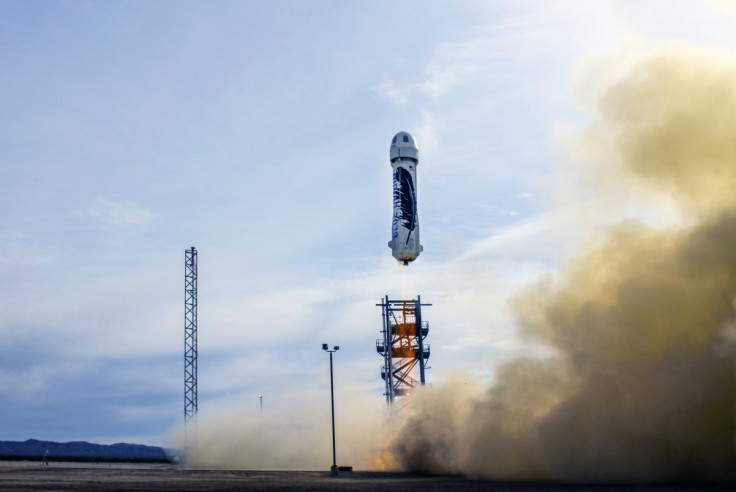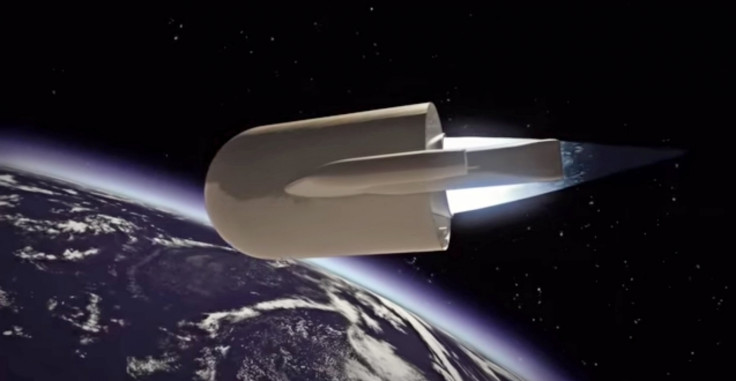Blue Origin's New Shepard: Six things you need to know about Jeff Bezos' reusable rocket

You may have heard in the news that Amazon CEO Jeff Bezos is claiming his spaceflight startup Blue Origin has made history by succeeding in launching and safely landing a rocket so that it can be reused – a feat that Elon Musk's SpaceX has so far been unable to accomplish.
But what is a reusable space rocket and what exactly is going on in the space development race? Join IBTimes UK as we break it down for you.
1. What is the New Shepard?
The New Shepard is a vertical take-off, vertical landing (VTVL) space vehicle that consists of a booster rocket and a crew capsule. It has been in development by Blue Origin since 2006, which was founded by Bezos to make commercial space tourism possible.
New Shepard contains a BE-3 liquid hydrogen-fuelled rocket engine that provides 110,000lb of thrust (more than 1m horsepower) at full throttle after launch. When the rocket returns to Earth, it can reduce that thrust to just 20,000lb, which enables it to make a vertical landing within a few feet of the target landing spot.
2. How did the New Shepard make history?
On 23 November, the New Shepard rocket travelled to the edge of space at a suborbital altitude of 100.5km (62 miles, 330,000ft). The unmanned crew capsule separated from the rocket and successfully landed in the desert by deploying parachutes. Most importantly, the rocket successfully returned to Earth, gently landing at a speed of 4.4mph on its original launch site.
3. What is Elon Musk's SpaceX working on?

SpaceX has been testing reusable rocket prototypes since 2013 and currently has a $1.6bn contract with Nasa to routinely ferry cargo to and from the International Space Station (ISS), using the Falcon 9 space rocket. Each time the Falcon 9 launched on a supply mission, SpaceX tried to retrieve the rocket and have it land safely back on Earth.
In 2015 it has made three attempts – once in January, once in April and once in June – but although the Dragon capsule (designed to carry humans and currently being tested with cargo) has proven it can be reused, the first and second stages of the rocket launcher have not been retrieved so far.
Musk's vision is to have the Falcon 9 land on an autonomous barge in the sea when it returns to Earth, but in April, the rocket touched down onto the drone ship and then tipped over. In January the Falcon 9 exploded when it tried to land, and in June, the rocket exploded just after lift-off.
4. What's the difference between the two rockets?
The difference between the New Shepard and the Falcon 9 is that the Falcon 9 wentinto orbit, rather than suborbital like the New Shepard. Because the Falcon 9 has to get into orbit to deliver the Dragon capsule to the ISS, the rocket is travelling at a speed of Mach 10 when it launches, compared to the New Shepard, which only hit Mach 3.7.
So means that even though the two space shuttles technically separate at the similar height of 80km, the Falcon 9 travels a much greater distance to a height of 145km, so the Falcon 9 has a lot farther to fall than the New Shepard as it actually went into space – plus it picked up a lot more speed.
Since Bezos' announcement, Musk has been reminding people on Twitter that SpaceX is trying to make orbital rocket landing possible, and that it already made it possible to land in water. Also, if it's about suborbital reusable rocket landing, Musk says the SpaceX Grasshopper already accomplished this in 2013, only at a lower height of 0.25km.
Perhaps it's sour grapes, but he also argues that the first reusable suborbital rockets were Burt Rutan's SpaceShipOne, an experimental air-launched rocket-powered aircraft and the North American X-15 experimental hypersonic aircraft, which both technically made suborbital spaceflight because they reached 100km in altitude.
Congrats to Jeff Bezos and the BO team for achieving VTOL on their booster
— Elon Musk (@elonmusk) November 24, 2015
Getting to space needs ~Mach 3, but GTO orbit requires ~Mach 30. The energy needed is the square, i.e. 9 units for space and 900 for orbit.
— Elon Musk (@elonmusk) November 24, 2015
But credit for 1st reusable suborbital rocket goes to X-15 https://t.co/LSb0f8FLJd
— Elon Musk (@elonmusk) November 24, 2015
And Burt Rutan for commercialhttps://t.co/TGWlNjsyQz
5. Why do we need reusable rockets?
At the moment it costs on average about $1.5bn (£1bn) per flight to send a shuttle into space, and due to the fact that excess weight slows a spacecraft down once it is in space, different stages of the space shuttle detach once the shuttle has cleared Earth's orbit. And these parts are just thrown away – including the rocket, which makes up most of the launch cost.
So Musk's vision was that if SpaceX could build a three stage-rocket that would separate as per normal and then fly back to its launch location on Earth to be used again, then this would reduce the cost of space flights 100 fold, making it easier to launch satellites and get many more people into space.
Since Nasa retired its space shuttles, it is no longer able to fly astronauts to the ISS from the US, and instead has to pay Russia more than $70m per seat every time American astronauts need to be sent to the station. A reusable rocket would make it possible for Nasa to reinstate the program at a lower cost, since the financial crisis has seen the US Congress slash space funding.
6. What progress are space companies making?

Blue Origin is working on the BE-4 engine, which would make it possible for the New Shepard to get into orbit. It will begin tests in 2016 and it should be flight-ready by 2017 so that it can be deployed in United Launch Alliance (ULA)'s Atlas V and Delta IV rockets.
Meanwhile, Boeing and Lockheed Martin, who own the ULA joint venture, wants to use helicopters to catch the rockets when they return to Earth rather than making a controlled landing, and Airbus is testing a reusable space launcher that sprouts wings and then autonomously flies back to Earth.
Virgin Galactic is also in the race to make space tourism possible, but its SpaceShip 2 crashed in November 2014, killing one person due to a co-pilot error.
© Copyright IBTimes 2024. All rights reserved.






